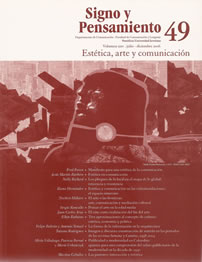Resumo
El artículo describe las nuevas formas de resistencia en las mallas de poder económico y semiótico del devenircapitalista. Imperio, con sus signos globalizados de carácter transfronterizo, ha ido reemplazando los antiguos símbolos de arraigo y pertenencia. Una red transemiótica de conectividad e indiferenciación marcada por el movimiento perpetuo de las significaciones y por la velocidad de los intercambios. Como propuesta, avanza en el concepto de hibridez mediante la problemática de la traducción cultural, que, con el traslado de significados de una cadena de signos a otra, termina produciendo rupturas entre lo global y lo local.Appadurai, A. (2001), La modernidad desbordada. Dimensiones culturales de la globalización, Montevideo, Tri
Bensaíd, D. (2006), Clases, plebes, multitudes, Santiago, Palinodia.
Bové, P. (1992), En la estela de la teoría, Valencia, Cátedra.
Braidotti, R. (2000), Sujetos nómades, Buenos Aires, Paidós.
Clifford, J. (1989), “The Global Issue. A Symposium”, en Art in America, july, p. 87.
Deleuze, G. (1987), Foucault, México, Paidós. García Canclini, N. (1989), Culturas híbridas. Estrategias para entrar y salir de la modernidad, México, Grijalbo.
— (1999), “Hacia una agenda cultural de la globalización”, en La globalización imaginada, Buenos
Aires, Paidós.
Hardt, M. y Negri, A. (2002), Imperio, Buenos Aires, Paidós.
Harraway, D. (1995), Ciencia, cyborgs y mujeres. La reinvención de la naturaleza, Madrid, Cátedra.
Laclau, E. (2005), La razón populista, Buenos Aires, Fondo de Cultura Económica.
Martín-Barbero, J. (1987), De los medios a las mediaciones, México, Gustavo Gilli.
Moreiras A. (1995), “Postdictadura y reforma del pensamiento”, en Revista de Crítica Cultural,
núm. 7, p. 29.
— (2000), “Hegemonía y subalternidad”, en Moraña, M. (edit.), Nuevas perspectivas desde/sobre América Latina. El desafío de los estudios culturales, Santiago, Cuarto Propio-Instituto nternacional de Literatura Iberoamericana.
Palti, E. J. (2005), Verdades y saberes del marxismo, Buenos Aires, Fondo de Cultura Económica.
Raunig, G. (2005), “La doble crítica de la parrhesia.
Respondiendo a la pregunta ‘¿Qué es una institución (artística) progresista’?”, en Arte. La imaginación política radical, Viena, Brumaria 5.
Scott, J. (1999), “Experiencia”, en Hiparquia, vol. x, núm. 1, p. 77.
lce-Fondo de Cultura Económica.
Barthes, R. (1987), El susurro del lenguaje, Barcelona, Paidós.
Bauman, Z. (1999), La globalización. Consecuenciashumanas, Buenos Aires, Fondo de Cultura
Económica.

Este trabalho está licenciado sob uma licença Creative Commons Attribution 4.0 International License.
Copyright (c) 2021 Nelly Richard


